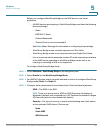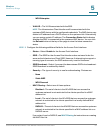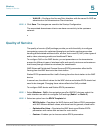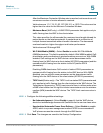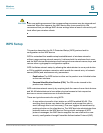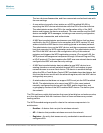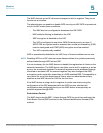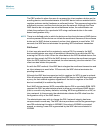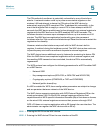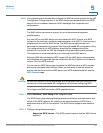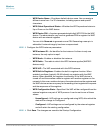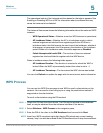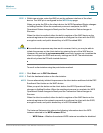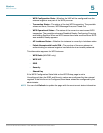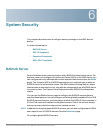
Wireless
WPS Setup
Cisco Small Business WAP551 and WAP561 Wireless-N Access Point 98
5
The PBC method is when the user of a prospective client pushes a button on the
enrolling device, and the administrator of the WAP device with an enabled built-in
registrar pushes a similar (hardware or software) button. This sequence begins the
enrollment process, and the client device joins the network. Although the Cisco
WAP devices do not support an actual hardware button, the administrator can
initiate the enrollment for a particular VAP using a software button in the web-
based configuration utility.
NOTE There is no defined order in which the buttons on the client device and WAP device
must be pressed. Either device can initiate the enrollment. However, if the software
button on the WAP device is pressed, and no client attempts to enroll after 120
seconds, the WAP device terminates the pending WPS enrollment transaction.
PIN Control
A client may also enroll with a registrar by using a PIN. For example, the WAP
device administrator may start an enrollment transaction for a particular VAP by
entering the PIN of a client. When the client detects the WPS-enabled device, the
user can then supply its PIN to the WAP device to continue the enrollment process.
After the WPS protocol has completed, the client securely joins the network. The
client can also initiate this process.
As with the PBC method, if the WAP device begins the enrollment transaction and
no client attempts to enroll after 120 seconds, the WAP device terminates the
pending transaction.
Although the WAP device supports a built-in registrar for WPS, its use is optional.
After an external registrar has configured the WAP device, the WAP device acts as
a proxy for that external registrar, regardless if the built-in registrar of the WAP
device is enabled (it is enabled by default).
Each WAP device stores a WPS-compatible device PIN in nonvolatile RAM. WPS
requires this PIN if an administrator wants to allow an unconfigured WAP device
(that is, one with only factory defaults, including WPS being enabled on a VAP) to
join a network. In this scenario, the administrator obtains the PIN value from the
configuration utility of the WAP device.
The administrator may wish to change the PIN if network integrity has been
compromised in some way. The WAP device provides a method for generating a
new PIN and storing this value in NVRAM. If the value in NVRAM is corrupted,
erased, or missing, a new PIN is generated by the WAP device and stored in
NVRAM.



